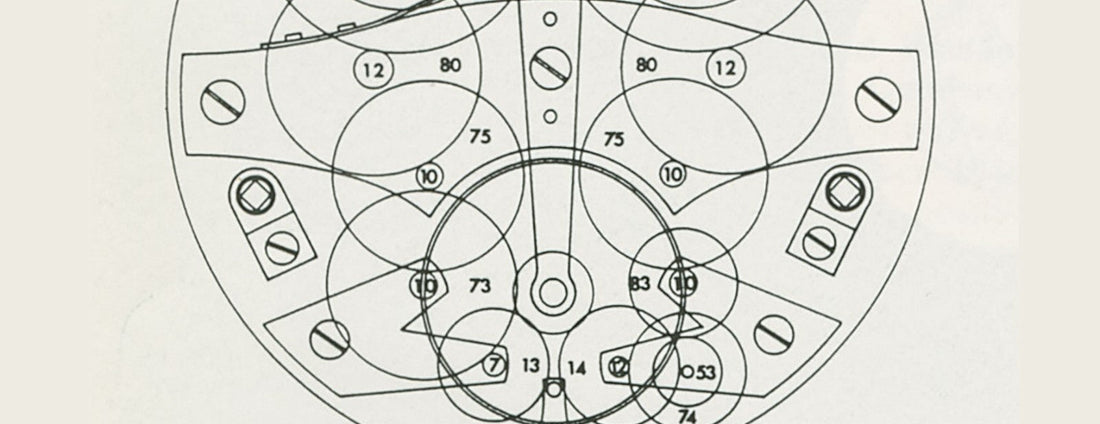
George Daniels Space Traveller 1: A Revolutionary Watch
Share
The most obvious initial question we need to answer about our Space traveller project, is why this watch? What is special about Space Traveller and George Daniels that has made us decide to try and emulate his work to set a standard for our workshop?
The Space Traveller 1 watch stands as a true masterpiece of horological innovation. This watch combines the art of traditional watchmaking with an astounding level of technical sophistication. It’s more than just a beautifully crafted timepiece—it also featured ground breaking mechanics, particularly in how it displays time in two forms: mean solar time and sidereal time. To truly appreciate the watch, it's important to understand its origins, how it works, and the significance of these two different methods of measuring time.
The Origins of the Space Traveller 1
George Daniels, a man widely regarded as one of the greatest independent watchmakers of the 20th century, was a pioneer in reviving traditional methods of watchmaking while also pushing the boundaries of watchmaking. Born in 1926 in the UK, Daniels’s work was highly influential in the world of horology and remains so to this day, and he was a driving force behind the revival of the English watchmaking tradition. Perhaps his most famous achievement was the creation of the Co-Axial escapement, a movement that would later become a hallmark of Omega watches.
With Space Traveller Daniels set out to create a watch that would not only show the passage of time with two separate trains, but also honour space exploration which was very much on his mind at the time. This led to the creation of the watch in 1982, designed to reflect Daniels’s philosophy of combining artistry with technical innovation. Daniels created just 2 of these watches, and they are considered among the most coveted pieces in the world of horology. My person preference is for the 1st version as I value it's simplicity when compared to version 2 with it's chronograph complication. It will also be a more realistically achievable project whilst still being a massive task which will require us to stretch our limits and improve our capabilities to complete.
How It Works: The Mechanics of the Space Traveller 1
The watches most significant feature is its dual time display. It has two separate dials that display two types of time: one shows mean solar time, and the other shows sidereal time. Each of these dials operates with its own unique set of wheels and pinions. Daniels was assisted with their calculation by Dr Henry Daniels of Cambridge University. These two complicated train counts, design to keep 2 different rates of time using only full teeth and a single escapement are a mathematical marvel. Daniels provided these tooth counts in his book Watchmaking to allow future generations to make use of them. We are picking up that baton and attempting to do justice to the excellent work.
Mean Solar Time:
Mean solar time is the time we typically think of when we talk about the passage of a day. It is based on the Earth’s rotation relative to the Sun. The time is measured from one solar noon (when the Sun is highest in the sky) to the next, which is approximately 24 hours. However, the Earth’s orbit and rotational speed are not perfectly constant, and there are slight variations, so we average these out over the course of the year to create “mean solar time.”
In Space Traveller, the main dial displays mean solar time, using a conventional system that adjusts for the Earth's position relative to the Sun. This is the time that most of us use for our daily lives, which is based on the concept of 24-hour days.
Sidereal Time:
Sidereal time, on the other hand, is a more precise method of measuring time. It is based on the Earth's rotation relative to distant stars, rather than the Sun. A sidereal day lasts about 23 hours, 56 minutes, and 4 seconds—slightly shorter than a solar day. This difference is due to the Earth's orbit around the Sun; as the Earth orbits, it takes a bit longer to align with the Sun again. However, it aligns differently with a distant star.
Sidereal time is especially important for astronomers and those who study celestial bodies, as it allows for precise tracking of stars and other celestial objects. In the Space Traveller 1, the secondary dial shows sidereal time, giving users the ability to track the position of the stars.
The watch employs two separate trains to ensure that the sidereal time dial runs independently from the solar time dial, all while ensuring the watch’s accuracy.
For the horological enthusiast or serious collector, the technical feat of this watch is incredibly impressive. It’s a testament to George Daniels’s skill and vision, combining precision engineering with an almost artistic level of craftsmanship.
Space Traveller is a masterclass in horological engineering. Its ability to display both mean solar time and sidereal time reflects the vision of George Daniels as a watchmaker, one who was fascinated by the intersection of timekeeping, astronomy, and mechanics.
